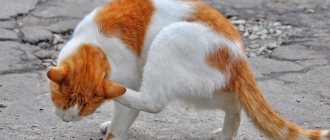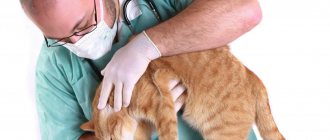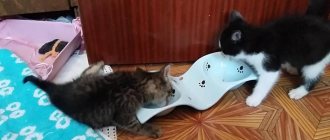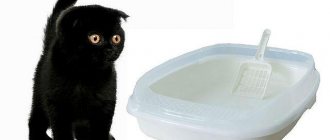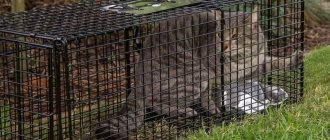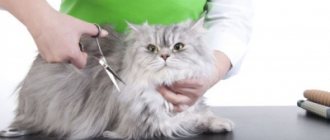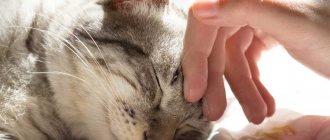Ringworm in cats is a fungal infection of an animal. What is the cause of the disease? In the first place is infection. Reduced immunity, allergies, and viruses are also prerequisites for the disease. More recently, 20 years ago, even 10 years ago, the disease was considered incurable. Pets were euthanized. Fortunately, today lichen in cats and kittens can be treated. The disease is contagious; it can infect other animals and, which is very unpleasant, people.
It is necessary to be vigilant and at the first signs of deprivation (we will talk about them a little later) not to self-medicate, but, having grabbed your pet, come to an appointment with a veterinarian for an accurate diagnosis. Many people encounter this for the first time, panic, search on forums, ask friends what to do? Yes, you can listen to advice, but! you should calm down and come with your cat to a doctor's consultation. By being patient and receiving the necessary treatment methods, you can help your pet recover.
In the article we will talk about the types of ringworm, its symptoms, and will dwell in more detail on the treatment of ringworm and prevention.
What does lichen look like in animals?
In domestic dogs, lichen usually appears on the pet's face, belly, and paws. First, single lesions appear, then the infection spreads throughout the skin. The first changes affect the condition of the coat. Hair becomes brittle and falls out. Bald areas are characterized by a rounded shape with fairly clear boundaries.
Over time, the skin begins to peel off, change color, and inflammatory processes are possible. The pet becomes lethargic and passive. Sometimes the temperature may rise.
Symptoms of ringworm in pets
First, your pet develops a rash. Then the hairs begin to break and the fur begins to fall out (hence the name “haircut”). Itching causes the animal:
- irritability;
- discomfort;
- anxiety;
- loss of appetite.
Lack of treatment leads to the appearance of “rings” on the skin - round spots with a red border. They may itch and peel, and after a while blisters appear. They are replaced by purulent, weeping wounds. If the disease continues to be ignored, the infection will enter the bloodstream and the fungus can affect the brain. As a result, the pet will die.
How to treat ringworm in animals
If you notice symptoms of ringworm, see your doctor immediately. Treatment is a must! The skin disease will not go away on its own, but the owner may become infected. Therefore, it is important to isolate the animal and provide it with a separate room (a spacious cage).
For the treatment of ringworm in dogs, medications are as follows:
- Vakderm is a vaccine that is used to prevent and treat fungal infections.
- Liverazol is a solution for external use, intended for the treatment of dermatophytoses.
- - a good answer to the question of how to treat lichen in a cat. The ointment kills fungus and harmful bacteria, improves skin regeneration.
- Zoomikol is an anti-lichen spray for cats and dogs that has fungicidal activity and is easy to use.
If there is a risk that the animal will lick the ointment, put a collar on it. Otherwise, in attempts to get rid of the unpleasant odor, it may become poisoned.
What to do if your pet has ringworm
Take precautions:
- During treatment, you should not bathe the animal.
- If there are other pets at home, do not allow them near the sick animal, give it a separate bowl.
- Do not pet your pet and do not allow children to have contact with it.
- Clean the apartment with disinfectants (bleach and hot water).
- Ventilate the room where the sick animal is located.
- Do not walk your dog for long periods of time so as not to infect other pets.
- To disinfect the room, turn on the quartz lamp daily. The sick animal must first be removed from the premises.
Do not kick your pet out of the house or kill it for fear of becoming infected. Consult your doctor to find out how to treat ringworm in your dog and cat. Remember: the infection can be treated!
Causes
Ringworm develops due to infection of skin areas by fungi.
As mentioned, the occurrence of lichen is provoked by the spores of Trichophyton, Microsporum canis and Microsporum qypseum. Fungi live not only on the cat, but also spread to all objects with which it has come into contact. This could be brushes, furniture, bedding, or fallen fur. Fungal spores live for about two years. Infection does not always occur immediately after the appearance of dermatophytes; they may not be detected for several months.
Important! The active development of fungi begins when exposed to a warm and humid environment.
The disease is transmitted through contact with spores that may be located on an infected cat. Fortunately, not all animals are susceptible to this infection. At risk are:
- Kittens under 1 year of age, sick individuals and cats not receiving proper nutrition.
- Animals that have free access to the outdoors. Their immune system is not strong enough to fight off infection.
- Persian cats. The instability of these animals to the disease is explained by the long process of selection, as a result of which they were bred.
Ringworm from infected cats is transmitted not only to other animals, but also to people. Children are especially sensitive to it. A person's nails and scalp are affected.
The main signs of pityriasis versicolor in dogs and cats
The fungus affects the hair follicles, which negatively affects the animal's coat, causing seborrhea and baldness. If the infection gets on the claws, they peel off and collapse.
The spots are yellow-brown in color, the edges resemble lace. They peel off, become covered with bran, and if left untreated, merge with each other. There is not always itching. In winter, the spots may disappear.
How to treat lichen in cats and dogs
Tinea versicolor is a non-contagious disease, so the pet does not need to be isolated. Therapy is similar to the actions for the ringworm form - Vakderm, Yam, Zoomikol. Make sure that the animal does not lick the medicine for lichen, otherwise it may be poisoned.
Pay special attention to immunity - take care of good nutrition, give vitamins and minerals. In summer, walk with the animal in the morning and evening, avoid direct sunlight. If your home has air conditioning, turn it on.
Treatment
Pharmacological drugs are used to fight infection. But you can speed up recovery using traditional methods.
Medication
Comprehensive treatment of ringworm ensures the best results
When lichen occurs, an integrated approach must be taken, which should include local treatment and the use of antifungal drugs. This method gives the most lasting and fastest effect. General therapy is no less effective, and treatment is carried out as a supplement.
Important! Local treatment is limited only in cases where we are talking about small kittens, for whom taking certain medications may be dangerous.
The duration of taking antifungal drugs is 6–8 weeks. Since the course of lichen depends on the state of immunity of the sick cat, their effectiveness is individual. A medicine that works for one animal may not work for another. Therefore, medications should be prescribed exclusively by a veterinarian.
The most common and effective drug is Itraconazole. Griseofulvin, Fluconazole, Terbinafine are also used, but they are slightly inferior in effectiveness to the previous drug.
Local therapy performs an auxiliary function, but it is an integral element of the treatment process. Topical preparations help destroy dermatophyte spores. These include:
- ointments Clotrimazole, Nizoral, Mycoseptin, Ecodax and Miconazole cream, which are used to treat small infected areas. These drugs are used in small quantities because animals lick them off;
- shampoos with antifungal effect Alezan, Synergy Labs, Veterinary Formula Antiseptic & Antifungal are prescribed once every 7 days for 5–6 weeks. They have a pronounced antimycotic effect;
- Creolin, Zoomikol, Yam Ointment, Lamikon, Enikonazole, birch tar and sulfur ointment are local preparations that give good results, especially at the initial stage of the disease. But they contain toxic substances, so their use is limited.
Vaccines Microderm, Polivac TM, Vakderm F are also used for treatment. They are used for both therapeutic and preventive purposes. For immunization, vaccines are administered 2 or 3 times with a break of 14 days. The dosage is determined depending on the age of the animal. A cat acquires resistance to the disease 25–30 days after vaccination.
For therapeutic purposes, the drugs are used 3 to 5 times with a break of 10–14 days. The effect of vaccines is aimed at exacerbating the course of lichen, which allows for loosening and rejection of formations from the lesions. The infection is suppressed in a short time, and the fungus does not have the opportunity to enter the chronic stage. Immunostimulants Fosprenil, Ribotan, Imunofan, Anandin, Cycloferron have a similar effect.
Traditional methods
Treatment with traditional methods is not without its advantages. All components are affordable and of natural origin. In particular, the following recipes can be distinguished:
- Birch charcoal is mixed with burdock root juice. Infected areas are rubbed with garlic, then lubricated with the prepared mixture. The duration of the procedure is 30 minutes.
- A leaf of white cabbage with sour cream is applied to the affected area. Only fresh vegetables can be used.
- An ointment is prepared from honey and beet broth and the skin is treated with the composition.
- Mix vinegar with mustard and apply to the body. It should be borne in mind that this procedure is not particularly pleasant, and the animal may resist.
- The affected areas are treated with a soap solution 3-4 times a day, which helps soften the crusts.
- Elecampane in the amount of 10 g is poured into 100 ml of hot water and left for 30 minutes. The animal is given a tablespoon to drink three times a day.
- Rub the sore spots with raisins cut in half.
- Burn a white sheet of paper on a plate. The resulting ash is mixed with a small amount of oil and applied to the affected areas.
- Turmeric is mixed with water until a mass is formed that resembles the consistency of sour cream, and rubbed into the skin 2-3 times a day until the lichen disappears completely.
- Ringworm is also treated with iodine.
Important! When using folk remedies, pharmaceutical drugs cannot be excluded.
Folk remedies in the photo
Honey
Beet
Burdock root
Raisin
Turmeric
Wetting form
Ringworm is a non-contagious disease better known as eczema. The mechanism of development of the disease is unclear. It is often based on allergies, hormonal imbalances, problems with the nervous system, climate, and ecology.
What does eczema look like in pets?
The disease develops according to the following pattern:
- A small hairless swelling appears on the skin, hot to the touch (either a single or multiple lesions are possible).
- Over time, it turns into a small bubble - a papule, filled with liquid.
- The vesicle gets wet all the time and secretes liquid, sometimes with pus. Due to the source of infection, the fur “sticks together” and looks unsightly.
What to do if your cat or dog has eczema?
If you notice symptoms of eczema in cats and dogs, take zinc ointment for treatment. This is an effective drug for eczema in dogs, which dries wounds, disinfects, and accelerates skin regeneration. You can also use Yam ointment.
Where does the infection come from?
A cat can become infected with shingles anywhere. First of all, walking down the street and communicating with other pets suffering from lichen. Also, the focus of fungi is objects after infected animals, these can be bedding, bowls, toys or wool on the floor with fungal spores. Spores can exist for up to a year without their victim.
Another source of infection are rodents, which are hunted by a meowing pet. But then the cat’s lichen will not be the only problem. By catching mice or rats, mustachioed pets can pick up other equally unpleasant diseases.
But furry pets who do not leave the apartment are also at risk of becoming infected with lichen. Because bringing fungus into your home happens more often than people realize. Coming home from the street, a person brings in various germs and dirt on the soles of his shoes, while people change their shoes into slippers, but pets come into direct contact with lichen with their paws.
A person gets a lichen infection from an animal through banal stroking of fur. Having a strong immune system, there is a chance to avoid the disease. But due to prolonged contact with a sick cat, infection can still occur.
Pink (shingles)
Pityriasis rosea is another skin disease of unknown origin. There are suggestions that it is inherited, has an allergic basis, or is caused by an unknown virus. Most doctors believe that the pathology is harmless, but some veterinarians disagree.
How does skin disease manifest in pets?
Externally, the disease resembles an allergy - small and large pink spots appear. They are flaky in the center, smooth at the edges. The pathology itself is not dangerous, but if bacteria gets into the wound, purulent inflammation is possible.
Diagnostics
As with other diseases, only a veterinarian can make a diagnosis, confirm or refute your guesses.
The doctor will conduct a comprehensive examination:
- using a Wood's lamp, examine the affected area; the primary method will most likely indicate the presence of lichen - if the diagnosis is confirmed, the fur under the lamp will acquire a green tint;
- examination under a magnifying microscope makes it possible to examine skin scales in detail and see microsporia on the skin or hairs;
- analysis of the scraping for the presence of a nutrient medium - for analysis, a scraping is made from the affected area and sent to the laboratory to identify parasites and fungi.
The first two methods are carried out directly in the doctor’s office, take a few minutes, but do not give a 100% result. The culture is analyzed within 21 days, and its reliability is 100%.
Prevention of lichen in pets
- Get regularly vaccinated against fungus (Vakderm).
- Keep street animals away from your pet.
- Check your pet's skin and coat regularly.
- Treat wounds and scratches with zinc ointment and other antiseptics.
- Maintain good hygiene.
- Treat your pet for fleas and ticks in a timely manner.
- Do not allow your pet to eat from other animals' bowls, especially if they are intended for outdoor dogs and cats.
- Contact your doctor as soon as you notice symptoms of skin diseases - suspicious hair loss, spots.
- Provide your animal with proper nutrition to avoid allergies, weakened immunity, and pathologies associated with metabolic disorders. Do not feed your pet table scraps, do not give fatty, peppery, or other unhealthy foods.
Tags
in cats and in cats and in infected cats and in cats and in cats generalized cats and in cats it is necessary to feed Feeding dogs Feeding cats Feeding rodents Feeding birds Feeding dogs Feeding cats Feeding rodents Feeding birds Feeding dogs Cats treat cats themselves. The type of disease is not dangerous for the disease.
dry stockspeoplecareconditionsproductsvitaminsskiveterinary fleasmore detailsmitebirdstoilet

